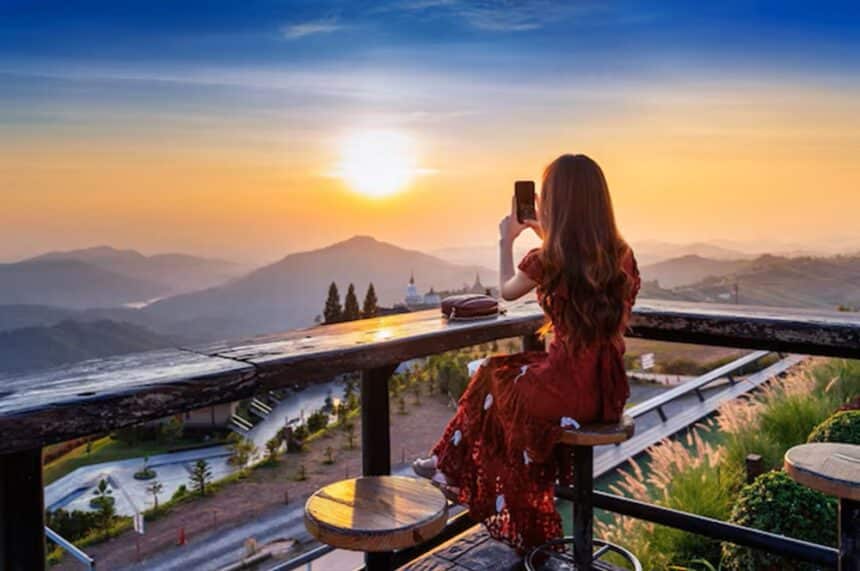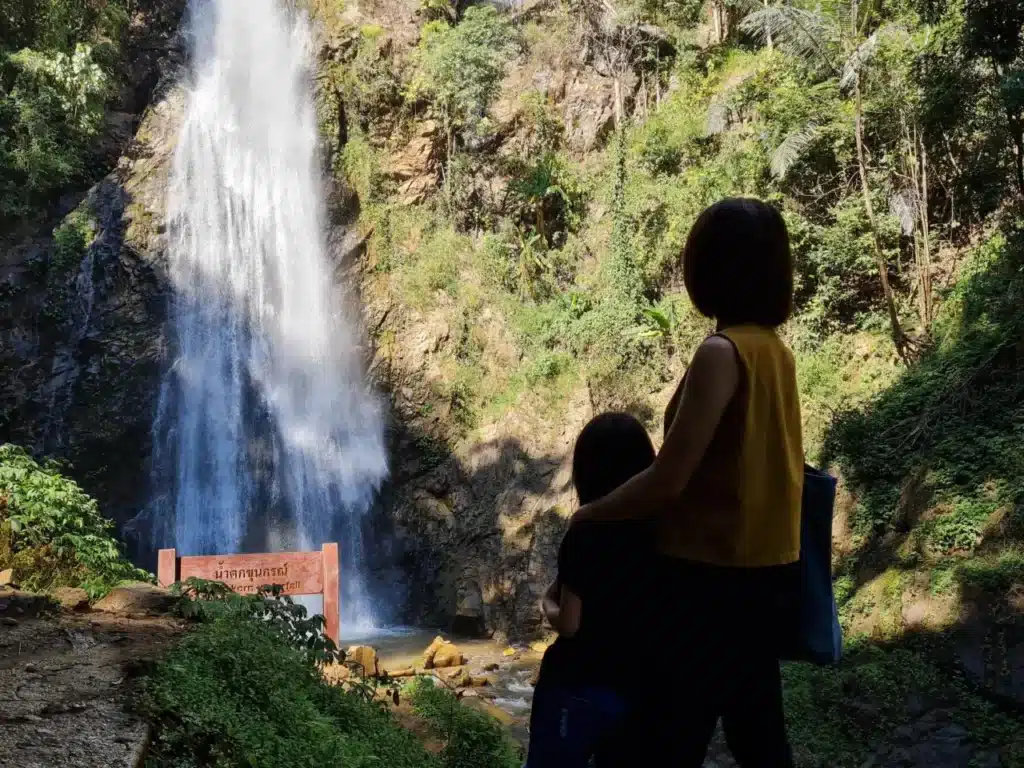Northern Thailand, once the core of the ancient Lanna Kingdom, has a way of staying in travellers’ minds. Golden temple rooftops, cool mountain air, and soft morning mist feel almost timeless.
Most visitors stick to well-known sights like Chiang Mai’s night markets, the famous White Temple, or laid-back Pai, and they are all worth a stop. Yet beyond those busy routes waits a more peaceful side of the North, full of small villages, hidden waterfalls, and quiet hilltops that still feel untouched.
This journey invites slower travel. It suits those happy to rent a motorbike, hire a local driver, or take their time in a songthaew instead of a tour bus. Starting in artistic Chiang Rai and weaving south to culture-rich Chiang Mai, this route highlights 10 breathtaking hidden gems in Northern Thailand, places that give real meaning to travelling off the main tourist track.
Chiang Rai’s Mountain Gate: Misty Ridges and Tea Hills
The trip begins in Chiang Rai, often called the capital of Thailand’s far north. The city has an easy rhythm, creative energy, and far fewer crowds than Chiang Mai. From here, the road heads east and north, through rolling hills and towards the highlands that grow some of the country’s finest tea.
1. Doi Pha Tang: Sunrise Above a Sea of Fog
While Phu Chi Fa has become well-known, its quieter neighbour, Doi Pha Tang, offers views that feel just as dramatic with a fraction of the crowd. The peak sits right on the border with Laos, and the cliff edge drops sharply into the deep valley below.
- The Experience:
Arriving before dawn rewards the early riser. On many mornings, a thick sea of fog, called talay mok, fills the Mekong valley, with the hills of Laos rising through the mist like islands. As the sun climbs, the clouds start glowing in shades of gold and pink. The area carries a layered history. Many locals are descendants of former Kuomintang soldiers from China, and the markets reflect a blend of Chinese and northern Thai culture. - Why It Is Hidden:
The road up is steep and winding, and most places to stay are simple homestays. This puts off package tours and keeps visitor numbers low.
2. Doi Mae Salong: Mountain Tea and Yunnan Heritage
High in the mountains west of Chiang Rai, Doi Mae Salong feels different from most of Thailand. Cool weather, Chinese-style shop signs, and rolling tea fields give the village a look that many compare to Yunnan.
- The Experience:
The hills are lined with bright green tea plantations. Travellers can walk through the fields, visit small family-run factories, and learn how local producers grow and process their famous oolong tea. Tasting sessions offer delicate brews with floral, buttery, or roasted notes. The climate stays fresh all year, so even a hot day feels pleasant. Many visitors start the morning with a Chinese-style breakfast, often a simple noodle soup with pickled vegetables and tea. - Why It Is Hidden:
Reaching Doi Mae Salong requires a long, twisting climb away from Highway 1. Large buses struggle with the bends, so they tend to attract independent visitors rather than big groups.
Quiet Corners of the Golden Triangle: Waterfalls and River Valleys
The route then drifts west and south into the wider Mekong watershed, where rushing waterfalls and forested ridges take the place of busy river ports.
3. Nam Tok Pu Kaeng: Seven Levels of Jungle Calm
Just south of Chiang Rai, on the way towards Phayao, sits Nam Tok Pu Kaeng, one of the highlights of Doi Luang National Park. Many travellers drive straight past without realising what they are missing.
- The Experience:
Pu Kaeng is not a single fall but a series of seven cascades, each with its own shape and pool. A shaded trail leads through thick forest, and reaching the higher levels requires a moderate hike. Roots and rocks make the path interesting but still manageable for anyone with basic fitness. The natural pools are cool and clear, a welcome break from the heat. Bird calls, running water, and the heavy green of the jungle give the place a deep sense of calm. - Why It Is Hidden:
The waterfall sits away from the usual tourist routes between Chiang Rai and Chiang Mai. Signs are mainly in Thai, which suggests the spot caters more to local visitors than to overseas guests.
4. Wat Phra That Chom Thong: Watching the Light Over Kwan Phayao
Phayao’s broad lake, Kwan Phayao, is one of the largest lakes in the North, yet the town rarely appears on standard tour plans. Overlooking the water from a gentle hill stands Wat Phra That Chom Thong, a temple that doubles as a natural viewpoint.
- The Experience:
The temple, which dates back several hundred years, has a quiet, devoted feel. Its main chedi shows classic Lanna style with a graceful, layered form. While the complex itself is pleasant, the real highlight is the view. From the terrace, visitors can see Kwan Phayao stretching across the basin, with fields, town streets, and distant hills wrapping around the water. Late afternoon is particularly beautiful, when the sun sinks low and turns the surface of the lake into soft silver and gold. It is an ideal place to sit in silence, say a short prayer, or simply watch the light change. - Why It Is Hidden:
Most travellers treat Phayao as a quick lunch or fuel stop on the highway. Few choose to stay overnight or explore the hills around the lake.
Heading South: Through the Rural Heart of Lanna
The middle part of the journey passes through Lampang and Lamphun, two provinces that still show strong Lanna character in their temples, markets, and old wooden houses.
5. Chae Son National Park: Hot Springs in a Forest Valley
In Lampang province, Chae Son National Park hides a network of natural hot springs in a lush, green valley. Despite its beauty, it remains strangely quiet with international visitors.
- The Experience:
The hot springs bubble up in open grassy fields beside a cool mountain stream. Visitors can soak their feet, rest in private mineral pools, or rent a room for a longer soak. The water reaches more than 80°C, which makes it perfect for one of the park’s simple pleasures: boiling eggs. Small baskets for eggs are available to rent, and signs show how long to leave them in for soft, medium, or hard yolks. Nearby, a forest path leads to Chae Son Waterfall, a tall, graceful fall surrounded by thick trees and moss-covered rocks. - Why It Is Hidden:
Lampang still sees far fewer tourists than Chiang Mai, and Chae Son sits another long drive from the city centre. Visitors need to set aside time rather than fit it into a quick schedule.
6. Wat Phra That Lampang Luang: A Living Museum of Lanna
Just outside Lampang city, Wat Phra That Lampang Luang ranks among the best examples of Lanna temple design in the region. It is both a workplace of worship and a glimpse into a much older era.
- The Experience:
The temple complex stands on a small mound within sturdy walls, which gives it a fortress-like look. Inside, the main viharn (assembly hall) is open-sided and full of carved wood, old murals, and a heavy scent of incense. One of the most intriguing features is found in a dark chamber near the chedi. With the door closed, a tiny hole in the wall projects a reversed image of the golden chedi onto a white surface, a natural version of the camera obscura. Monks and guides sometimes explain the effect to curious visitors. - Why It Is Hidden:
Thai people hold the temple in very high regard, but many foreign travellers focus on attractions closer to Chiang Mai or Chiang Rai and do not make room for Lampang in short trips.
7. Lamphun’s Old City Walls: Echoes of Hariphunchai
South of Chiang Mai lies Lamphun, believed to be the oldest continuously lived-in city in Northern Thailand. Long before Lanna rose to power, Lamphun was the capital of the Mon kingdom of Hariphunchai.
- The Experience:
The best way to feel Lamphun’s character is to move slowly through its old centre. Traces of the ancient walls and moat still surround the core of the city. Quiet lanes lined with teak houses and small shrines link one side to the other. At the heart of town stands Wat Phra That Hariphunchai, with its tall golden chedi that many locals hold as sacred as Chiang Mai’s Doi Suthep. Outside the big temple complex, visitors find narrow canals, shaded walkways, and homes where families still live in traditional wooden houses. - Why It Is Hidden:
Most people travelling between Lampang and Chiang Mai stay on the highway. Unless they make a deliberate turn into the centre of Lamphun, they miss the historic streets entirely.
Beyond Chiang Mai City: Villages, Caves, and Mountain Views
The last part of the journey circles into the mountains around Chiang Mai but keeps well away from the busiest city areas and tour buses.
8. Muang On Caves: A Giant Cavern and a Hidden Buddha
East of Chiang Mai city, not far from the road to San Kamphaeng, sits Muang On Caves (Tham Luang Mae On). Many travellers visit the region’s hot springs and sticky waterfalls, but these caves still see fewer visitors.
- The Experience:
A stairway leads up to the cave entrance, where a small shrine welcomes guests. Inside, the main chamber opens up into a vaulted space filled with tall stalagmites and long, tapering stalactites. Steps descend deeper into the hill until visitors reach a large reclining Buddha that lies in the quiet centre of the cavern. Light from the entrance and dim electric bulbs create deep shadows, which give the rock shapes a dramatic look. The air is cool and slightly damp, a welcome break from daytime heat. - Why It Is Hidden:
Although close to Chiang Mai, the caves do not appear on many standard tours. The focus tends to stay on other attractions in the same district.
9. Ban Mae Kampong: A Cool-Climate Village in the Hills
Further into the Mae On district, surrounded by dense forest and terraced plots, lies Ban Mae Kampong, a small village that has built its name on community-based eco-tourism while still keeping a strong local identity.
- The Experience:
The village hugs a narrow valley with a stream running through its centre. Houses sit on stilts along the road, with coffee beans drying on balconies and flowers hanging from wooden railings. Most guests stay in homestays, sharing meals with host families and waking to the sound of water and roosters. Daytime brings options like short hikes to nearby waterfalls, walks through tea and coffee plantations, and visits to viewpoints where clouds skim the treetops. Sitting with a mug of locally grown coffee and watching the fog drift across the valley can easily fill an afternoon. - Why It Is Hidden:
The road up to Ban Mae Kampong is narrow and steep, which naturally limits the number of visitors. The village has also set its own limits on guest numbers to protect its environment and way of life.
10. The Upper Reaches of Doi Suthep-Pui: Palace Gardens and Hmong Life
Almost every visitor to Chiang Mai hears about Wat Phra That Doi Suthep, perched above the city. Far fewer continue up the same mountain road to explore the rest of Doi Suthep-Pui National Park.
- The Experience:
Beyond the main temple car park, the road climbs higher into cool pine forest. The first key stop is Phu Phing Palace, the Royal Winter Residence, which opens to the public when the Royal Family is not staying. The grounds feature manicured gardens, old-growth trees, and sweeping views over the surrounding slopes. Further up, a small Hmong village offers a glimpse of local highland life. Stalls sell handwoven textiles, herbal teas, and seasonal fruit, and walking paths lead to viewpoints with wide angles over the Mae Ping valley and Chiang Mai city from behind the mountain ridge. - Why It Is Hidden:
Many visitors think the journey ends at Doi Suthep temple and never realise the road continues higher. Without a guide or advanced research, the upper reaches of the park remain out of sight.
Final Thoughts for the Lanna Traveller: Choose the Side Roads
Travelling from Chiang Rai to Chiang Mai can be as simple as a bus ride between two cities, yet it can also become a slow journey through the history and nature of Northern Thailand. The ten places above, from the sunrise cliffs of Doi Pha Tang to the home-cooked meals of Ban Mae Kampong, show how rich the region becomes once travellers step away from the main stops.
These are the kinds of locations that reward patience. They ask for a small detour down a side road, a night in a homestay instead of a hotel, or an early start for a foggy sunrise. For those who want real connection, quiet landscapes, and a taste of everyday northern life, this path offers something rare: space to breathe.
Rent a bike or car, hire a trusted local driver, pack a light bag, and move at an easy pace. Northern Thailand still holds many secrets, and some of its finest are found just beyond the usual map lines.


















